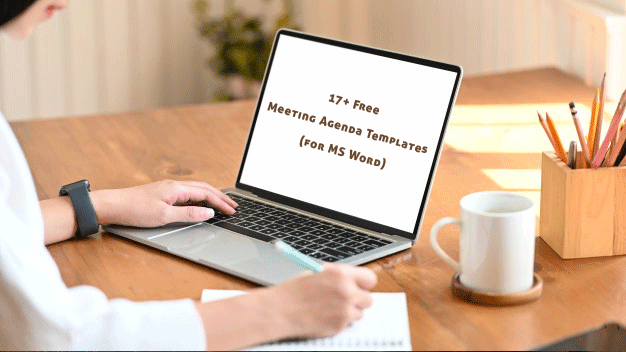A meeting agenda is the list of items that a team of persons you want to discuss and finalize an agenda during a meeting. Persons attending the meeting are usually given the meeting agenda before the meeting, and ideally, this should be at least 24 hours in advance. This gives every individual scheduled to be in the meeting with adequate time to prepare. However, it should be ideally given several days before the meeting, if possible.
With a well-thought-out meeting agenda, the effectiveness and was as to how fast the meeting is done can be approximated. The reason for this is that everyone gets to know in advance what will be discussed hence get to familiarize themselves with the topic.
Meeting Agenda Templates & Examples
Here are 20 meeting agenda templates in MS Word to help you in creating your meeting agenda.
Meeting Agenda Template 01

Meeting Agenda Template 02

Meeting Agenda Template 03

Meeting Agenda Template 04

Meeting Agenda Template 05

Meeting Agenda Template 06

Meeting Agenda Template 07

Meeting Agenda Template 08

Meeting Agenda Template 09

Meeting Agenda Template 10

How to Write A Meeting Agenda
Establish the meeting’s objective. This is, without a doubt, the most vital aspect you need to consider when drafting a meeting agenda template. Here, you should specify the reason for holding the meeting as well as the desired outcome once it is over. Because of this, everybody at the meeting gets to feel appreciated and understand better what the meeting is trying to achieve.
As you start writing the meeting agenda, try and concentrate on the objective while creating the whole meeting agenda. By doing this, you enhance the meeting’s efficiency even before it starts.
List the meeting agenda topics to be discussed. You should then proceed to list the topics that will be discussed after establishing its goal. Each of these topics should aim at attaining the meeting’s objective. When drafting these topics, make them brief but detailed enough to allow each member to prepare for the meeting properly. One way you can do this is by framing each topic as a question. This then initiates each member’s thought process and ensures relevance to the meeting’s objective is maintained.
Every topic has a specified duration to be covered and an owner who will be there to ensure accountability. The time frame ensures the meeting’s agenda is on schedule.
List all the required attendees. One of the primary challenges experienced when drafting a meeting agenda is deciding who to invite. When doing this, it is crucial only to include persons who will be of relevance to the meeting’s goal.
The best way of doing this is by identifying your meeting goals then assigning the meeting topics. Once you do this, it will be a lot easier to come up with a list of attendees. There are three questions you should ask yourself to help identify persons to invite for the meeting, and these are;
- Is the person required to be present to attain the meeting’s objective?
- Does the presence of this individual directly impact the outcome of this meeting?
- Does the person have the expertise or knowledge to impact the meeting’s outcome?
If it is still unclear who you should invite, consider sending a transcription, recording, summary, or post-meeting. In the business world, time is precious, and you should thus not waste everyone’s time by including persons that are not needed.
Leave a section at the meeting agenda’s end off-topic discussions and action items. Meeting follow-ups are just as essential as the meeting. Therefore, below the meeting agenda template, you can have a section that attendees can include takeaways, decisions, take notes, and document action items. This section helps organize the conclusions which have been arrived at the meeting, thereby enabling the attendees to visualize this process a lot better and know what is required from them.
Whereas unexpected topics may come up as the meeting is ongoing, it is important to always stick to the meeting’s agenda. You can only start discussing these off-topic questions once the meeting is over.
Verify the meeting details. If attendees are attending this meeting virtually, then it is necessary to double-check the details of the meeting. It would be best if you did this by confirming that each conference detail is outlined correctly and clearly. These include access code, dial-in numbers as well as any other link to this online meeting room.
Meeting Agenda Template 11

Meeting Agenda Template 12

Meeting Agenda Template 13

Meeting Agenda Template 14

Meeting Agenda Template 15

Meeting Agenda Template 16

Meeting Agenda Template 17

Meeting Agenda Template 18

Meeting Agenda Template 19

Meeting Agenda Template 20

Tips for Wring a Meeting Agenda
- Include a start and end time for every topic
- Ensure to set aside and include a period for breaks
- Confirm you have included a preparation task
- Have the meeting agenda reviewed by colleagues or other attendees
- Always distribute the meeting agenda before the meeting
Things to Avoid When Drafting a Meeting Agenda
- When writing a meeting agenda, there are a couple of things to avoid, including;
- Not preparing adequately for the meeting
- Distributing the meeting agenda at the actual meeting
- Giving attendees a disorderly agenda
- Offering insignificant and unnecessary details
- The use of terms that are not familiar to the company employees
After reading through this article, you are now better placed on writing a meeting agenda. Likewise, you know some of the things you should avoid doing. With this in mind, you are in a much better position to write a quality meeting agenda template.
Looking For Document Management System ?
Call Pursho @ 0731-6725516
Telegram Group One Must Follow :
For Startups: https://t.me/daily_business_reads





